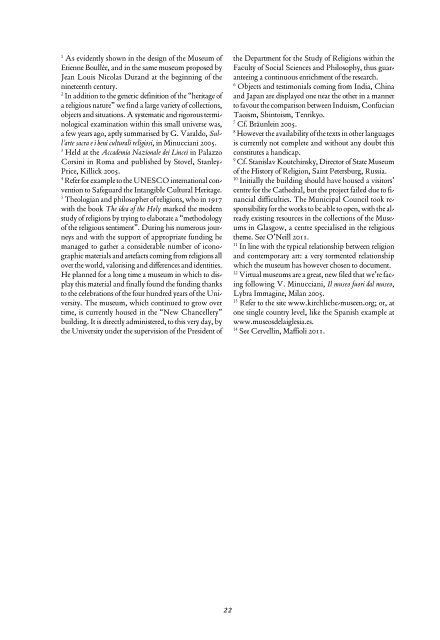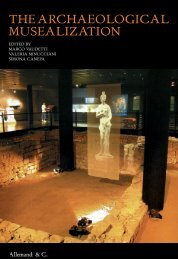RELIGION AND MUSEUMS - Allemandi
RELIGION AND MUSEUMS - Allemandi
RELIGION AND MUSEUMS - Allemandi
You also want an ePaper? Increase the reach of your titles
YUMPU automatically turns print PDFs into web optimized ePapers that Google loves.
1As evidently shown in the design of the Museum ofEtienne Boullée, and in the same museum proposed byJean Louis Nicolas Durand at the beginning of thenineteenth century.2In addition to the generic definition of the “heritage ofa religious nature” we find a large variety of collections,objects and situations. A systematic and rigorous terminologicalexamination within this small universe was,a few years ago, aptly summarised by G. Varaldo, Sull’artesacra e i beni culturali religiosi, in Minucciani 2005.3Held at the Accademia Nazionale dei Lincei in PalazzoCorsini in Roma and published by Stovel, Stanley-Price, Killick 2005.4Refer for example to the UNESCO international conventionto Safeguard the Intangible Cultural Heritage.5Theologian and philosopher of religions, who in 1917with the book The idea of the Holy marked the modernstudy of religions by trying to elaborate a “methodologyof the religious sentiment”. During his numerous journeysand with the support of appropriate funding hemanaged to gather a considerable number of iconographicmaterials and artefacts coming from religions allover the world, valorising and differences and identities.He planned for a long time a museum in which to displaythis material and finally found the funding thanksto the celebrations of the four hundred years of the University.The museum, which continued to grow overtime, is currently housed in the “New Chancellery”building. It is directly administered, to this very day, bythe University under the supervision of the President ofthe Department for the Study of Religions within theFaculty of Social Sciences and Philosophy, thus guaranteeinga continuous enrichment of the research.6Objects and testimonials coming from India, Chinaand Japan are displayed one near the other in a mannerto favour the comparison between Induism, ConfucianTaoism, Shintoism, Tenrikyo.7Cf. Bräunlein 2005.8However the availability of the texts in other languagesis currently not complete and without any doubt thisconstitutes a handicap.9Cf. Stanislav Koutchinsky, Director of State Museumof the History of Religion, Saint Petersburg, Russia.10Initially the building should have housed a visitors’centre for the Cathedral, but the project failed due to financialdifficulties. The Municipal Council took responsibilityfor the works to be able to open, with the alreadyexisting resources in the collections of the Museumsin Glasgow, a centre specialised in the religioustheme. See O’Neill 2011.11In line with the typical relationship between religionand contemporary art: a very tormented relationshipwhich the museum has however chosen to document.12Virtual museums are a great, new filed that we’re facingfollowing V. Minucciani, Il museo fuori dal museo,Lybra Immagine, Milan 2005.13Refer to the site www.kirchliche-museen.org; or, atone single country level, like the Spanish example atwww.museosdelaiglesia.es.14See Cervellin, Maffioli 2011.22







